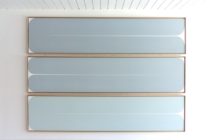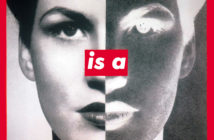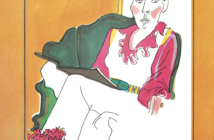Dear Artist,
After my last letter about fishing for art, the studio computer was bombarded with emails from readers wanting to know more. While I’m flattered that my systems might be of value to some, there are many roads to Rome, and there’s certainly no single route that subverts all others. While some of my systems may indeed be useful to people, many are peculiar to acrylic painting and the misguided methodologies I’m using right now. In checking out these ideas, please feel free to throw out what you will.
In the bush, I work on a half-dozen paintings at one time, generally on pre-primed, toned-ground canvases. Roughly speaking, there are three main stages, some of which may take place back in the cabin.
In the first stage, I try for a strongish statement of motif or idea with little or no prior drawing, generally working from foreground to background. I concern myself at this stage with overall pattern, but I also go to some effort to build texture. In acrylic, you have to work a little harder at texture than you do in oil. I generally pay scant attention to the actual scene and try to improve on Nature’s design. I like to equate this stage with playing a game of chess where you may be only moving up a pawn so that you might later strike with your horse or bishop.
The second stage takes place after the initial lay-in has dried. To tone down and give mother-colour to otherwise inaccurate colour choices made in my first stage, I often glaze the whole work with a transparent overall colour. To add a bit of confusion and fun I generally take a dry brush loaded with a bright colour and drag it here and there.
In the third stage, I punch in negative areas and deal with the direction of light and often counter-lit detail. I’m looking to build on the forms I’ve previously laid in. Frequently changing brushes for variety of stroke, I ask, “What could be?” and often find myself adjusting colours and shapes ad infinitum. At this point, I sometimes remove the painting from the paintbox and sort of cradle it in my arms for the final caresses. The tendency to overwork is discouraged by turning to another painting-in-progress. In the field, practical activities like wood gathering, fire stoking and weather watching make their contribution, and one takes heart from the knowledge that tomorrow will be another day.
Best regards,
Robert
PS: “Nature is usually wrong.” (James McNeill Whistler)
Esoterica: A useful ploy in plein air work is to try to achieve a state of rest. Painting from a box works well with the relaxed mode of cottage life — walking, bird watching, fishing, or just listening to the murmur of the water. When rest arrives, all’s well with the world, the brush slows down and the work itself becomes R and R. Right now I’m at Lake of the Woods, Ontario. It’s an area loaded with design potential and things of interest. While it’s difficult not to get excited, the idea is to stay calm and methodical, building and accepting each little bit as it arrives.
You can see some of the techniques mentioned in this letter by going to our free short videos.
Problem of perception
by Tiit Raid, Fall Creek, Wisconsin, USA
James McNeill Whister says, “Nature is usually wrong.” I beg to differ. It is the artist’s interpretation of nature that is usually wrong. Any artist knows that you do not need everything that is visible in a natural subject or any subject to make a successful painting. The ‘art’ is in the editing.
Look at any natural design. It is spot on in terms of balance and the organization of the elements, both structurally and visually. Then, carefully examine the vaster visual nature of any landscape; there too everything is in place. The problem is not with nature, it is with our ability to see it, and to know what to leave in and what to leave out. Don’t blame nature for our own inadequacies.
There is 1 comment for Problem of perception by Tiit Raid
Inexhaustible sources
by Ron Gang, Kibbutz Urim, Israel
I have been blessed with some fascinating natural areas all within 20 minutes walking distance from studio. Two or three days every week I load my gear, food and drinking liquids on my back and carry out one or two canvasses for a day-long session. No preliminary sketches as I use the largest canvasses I can carry. I have worked on the same paintings sometimes for 10 sessions and at other blessed times it all comes together in a day or two. Often there is fine-tuning in the studio, as the nature is too distracting for to see what has happened on the canvas. In the end all the components of the composition must work together as a totality.
While working in one location, I may catch out of the corner of my eye another scene or motif, or during my breaks, take a little stroll and discover a little corner that I’d never noticed before. There is a life’s work in this small area which is inexhaustible. As for wildlife, when we’re standing still in the same spot for hours, we become part of the land. The rest of nature accepts us as just another neighbor. The birds, snakes, tortoises, mongooses, wild cats, foxes, and even a rare large monitor lizard (that happened just once) are never looking for a fight, so if you don’t engage them, they just carry on in their way. Friendly relationships have formed with the Bedouins shepherds during their sheep grazing season in these parts. While they no doubt look upon me as a strange fellow, my basic knowledge of Arabic and attitude of respect for them have helped. The biggest hardship is the summer heat and sun, so by July I have to retreat to shaded areas.
Immersed in your own errors
by D. C. Cook, London, UK
As an artist continues in his craft he or she develops systems that are often contrary to conventional wisdom or even academic practices. It behooves an artist to pay attention to these aberrations and try to understand their purpose and usefulness. They are actually the keys to personal style and unique work that stands out from the work of others. If we all did things “correctly” all work would look the same and would, of consequence, be boring. Pay attention to your persistent errors, they are your personality made visible. The most important thing in art is not to be boring.
Visually editing the subject
by Edna Hildebrandt, Toronto, ON, Canada
Your topic on immersion is very interesting and I am learning a little bit. I have the tendency to start a drawing without any thought of how it may turn out. Instead I look at what is actually in front of me that caught my attention. Then I will change it to look like, what I believe, might look better. I might change it more drastically as I go along. Sometimes my imagination might wander, I would add more to the scene than what was initially there. Would that be called immersion? I am here to learn.
Fully embracing the subject
by Mark A. Brennan, Whitehill, NS, Canada
I am a huge fan of immersion and often find myself in the strangest wildest places letting it all soak in. I feel that to actually be in a place, one has to feel the cold and the biting insects. The quiet or the serenity can really do us painters wonders. My own methods are somewhat similar but I usually paint in oil and get instant gratification and plenty of texture. I tend to use an un-primed masonite board which gives the rich colour that toned down look we seek. I work fairly quickly and am looking for an impression not a photograph!
There is value for painters to immerse yourself in your subject matter. That way, we come to love, appreciate and study our subject on so many different planes. Even the smallest things like the nip of a Black fly or the gentle waving of a forest flower can be reflected in a work. Recently I have been experimenting with time lapse photography, just the simple act of setting up a camera towards a river or as the sun is going down can open up new doors to really get a feel for the rhythm or flow of a place. It opens up a new dimension, kind of like going snorkeling for the first time! In two weeks, I leave for the wilds of Newfoundland and Labrador to paint and am going to break with my traditional oil on board and instead swing to your side and work on location in acrylic on canvas for its quick drying and ease of transport, but whatever the results, it will indeed be total immersion.
Second breath
by Helen Ripley, Chicago, IL, USA
It all depends how you value your time. In this day and age we are bashed about by so many distractions and other imperatives that it is difficult for the self-respecting artist to find blocks of time that are long enough for full immersion. The idea is to get yourself into some remote place or environment where social opportunity is lessened and time wears heavily. It is often in the absence of stimulation where stimulation is at its greatest. In Robert’s book The Painter’s Keys, he has quoted the American writer Annie Dillard: “You need a room with no view so memory can meet imagination in the dark.” This is so true. Immersion is almost like a second breath that you get from staying the course in a state of relative blankness and tranquility.
Nature is not flawed
by Helena Tiainen, Berkeley, CA, USA
I can’t believe that Whistler made such an audacious statement! Did he think he was separate from nature and somehow existed on this planet without nature? I happen to believe that nature is possibly always right. The picture that we see and perceive as humans is so small in comparison to the view of it all that we have to alter it to fit well on the canvas, no matter how large the size of the canvas. Whether this is an improvement is questionable. It is more like in order to fit human concepts of balance and harmony we alter what we perceive. This is the nature of human creativity. But also this is part of what I would call nature. There is not one project created by man that is not immersed in or influenced/inspired by the form and function of the natural world around us.
Learning to appreciate
by Jim McGill
Actual hunting and fishing are in a state of decline in North America. Somehow the thrill has gone out of these blood sports to some degree, the spirit transferred to other more gentle pursuits such as bird watching, photography and, yes, plein air painting. Countries such as Costa Rica now earn a high percentage of their foreign income from eco-tourism. It doesn’t take a lot of imagination to realize that the true value of some of these remote spots is the beauty and centering that they offer the human soul. For better or for worse we are beginning now to appreciate nature rather than consume it.
Base of creativity
by Rose van Staden
Do you prepare your backgrounds with a greyish colour?
(RG note) Thanks, Rose, and everyone else who asked this question. If you paint on a medium pearly grey background your surface will be sufficiently toned down to take lighter lights and yet areas where the ground shows through can still be considered as painted. You can also paint on a bright coloured ground — say rose red in order to liven up the general feel, or you might think of painting on a darker ground so that opaque lighter colours really jump out. If you work on a darker ground it’s a good idea to seal the surface well so that the darker colour does not bleed through and darken all colours painted on top of it.
Archived Comments
Enjoy the past comments below for More immersion…
I like the info about painting on the go. I am off to France this fall for awhile and plan to take equipment to paint. I have a marvellous telescoping easel that I bought second-hand, with its own case and carrying strap,and it is easy and light to carry and set up. A friend of mine also put me onto “the film case method” of transporting acrylic paint in smaller quantities than tubes. I bought a clamshell box for little money at the dollar store and it holds a fair number of the film cases with paint in them. They don’t leak and are big enough to hold paint for an afternoon of plein air painting. It’s a marvellous idea, even if you don’t want to use them exclusively, you can take a long a couple of these with your tubes, if you want a bit of a colour that is in a larger container!
If nature is usually wrong, why do untold artists paint nature? That Whistler quote is absurd to me. Paint from your mind or imagination if you think you can do it better than nature.
Thank you for encouraging us to get out there and paint. Most of us are discouraged by the thought of taking ‘everything’ with us. I agree make it simple – and it works. I personally use a tackle box it carries everything I need from water colour to acrylics.
In defence of Whistler, let’s all just lighten up a bit folks. The man’s just saying if you direct copy nature without editing, morphing or cannabalizing you are doing something but it aint art. Just think about the art of the masters that moves you. Did the artist slavishly reproduce exactly what he/she was presented with? Probably not. What moves me about Whistlers work is strong value design not correct and accurate reproduction. FWIW
I think it’s hilarious that so many people feel the need to “Defend Nature”. I really don’t think she got her feelings hurt!
Ditto Bill Hibberd. Whistler was eccentric to say the least and was always controversial. Many of his (concise) statements were made to inflame and cause comment, which he still does today. Your observations are on the money concerning him. For me, that is exactly what he intended.
Of course nature is always wrong! How else would every living thing evolve to the next level? Not by replicating pre-existing perfection. For me at least, I did not get to my present level of perfection without making some serious mistakes.
It makes no sense for nature-lovers to take umbrage at Whistler’s comment that “nature is usually wrong”. Just about everything this genius produced had more than a touch of irony about it and this comment is no exception. I am sure he was referring to the need to “tweak” the scene so that it fits into the rectangle of our composition as we all need to do more often than not. His is one of my favorite art quotes.
Ohhhh, I love these letters — and the comments that follow! Thanks again so much, Robert Genn!

Transistory Shadows pastel painting, 24 x 36 inches |
You may be interested to know that artists from every state in the USA, every province in Canada, and at least 115 countries worldwide have visited these pages since January 1, 2013.
That includes Rose van Staden who wrote, “I am thrilled to see your videos, the beautiful paintings, and the adorable dog!”
And also Al Greif who wrote, “I frankly don’t know your main thrust. What are you trying to do in the art world?”
And also Gayle Tharp of Greenup, IL, USA who wrote, “I would like to add a note to the quote by Whistler: ‘Nature is usually wrong’ or ‘You may be looking at it from the wrong perspective.’ ”
And also Sally Kaiser of Golden, CO, USA who wrote, “After 7 years I am returning to digital arts, and your letters have helped me down that path!”









1 Comment
From the brushstrokes emerges a dialogue between artist and environment. In the dance of creation nature whispers its truths guiding the hand to unveil its timeless beauty.
Lawn Maintenance Services in Myrtle Beach